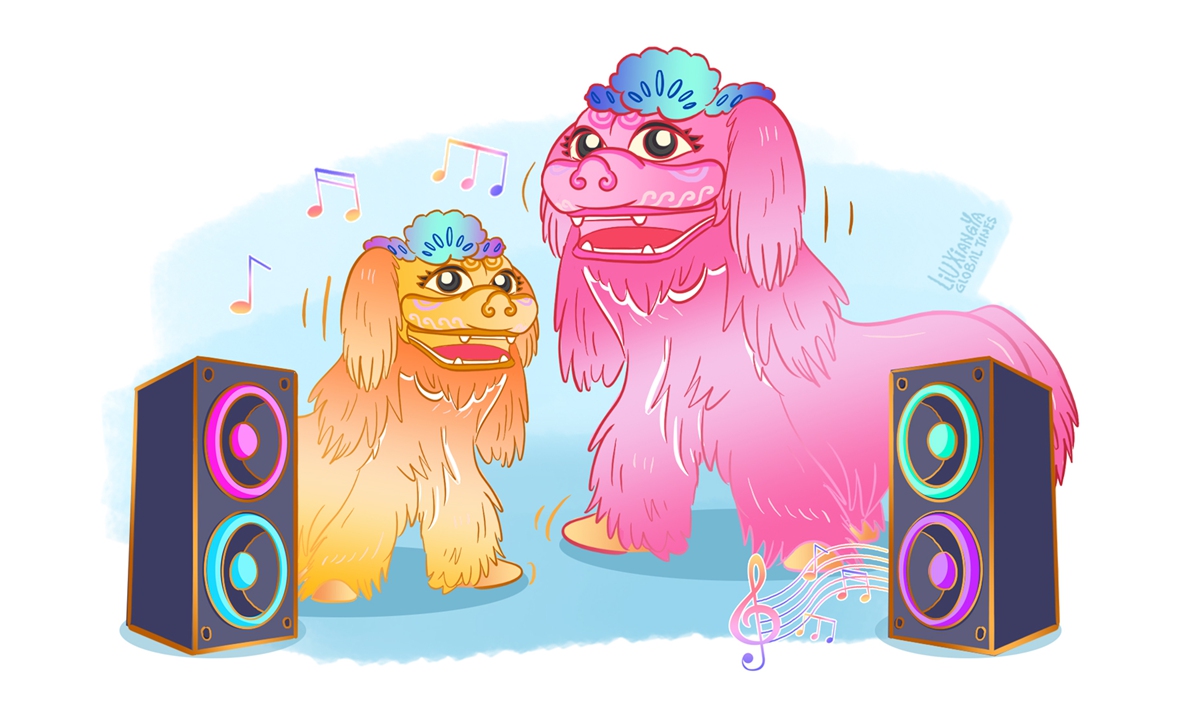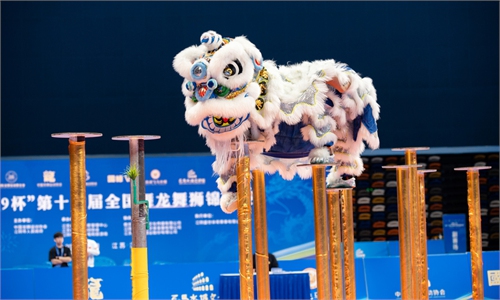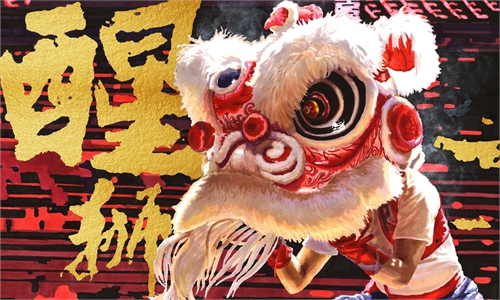ARTS / CULTURE & LEISURE
Lion dance’s new beat connects generations
Does blending lion dance with pop hit 'APT' overthrow tradition or innovate on it?

Illustration: Liu Xiangya
As the Chinese New Year approaches, lion dance troupes across the nation are diligently preparing to showcase their skills. What happens when the traditional lion dance meets the smash hit "APT."? Is this an overthrow of tradition or an innovation on heritage? A video that has gone viral on China's social media has stirred heated discussion about this trend.
"Tradition is also alive. It is not fixed or unchanging. Tradition has always been moving forward. If a few dance moves by young people could completely overturn tradition, then tradition would be way too fragile, wouldn't it? Just a few moves can't possibly ruin tradition. It's simply not realistic," Sun Jiashan, an associate researcher at the Central Academy of Culture and Tourism Administration, told the Global Times.
At a recent competition for martial arts and dragon and lion dancing held in Changsha, Central China's Hunan Province, a lion dance troupe from Hunan Normal University delighted the audience with lively tail-wagging, head-shaking, and winking movements to the beat of the hit pop song "APT." by Rosé and Bruno Mars. A single video of this performance uploaded to Douyin, the Chinese version of TikTok, received more than 2.5 million likes, over 100,000 comments, and nearly 2 million shares.
While the viral video has inspired lion dancers nationwide to imitate and share their performances online, it has also ignited a debate: Does blending modern pop culture with a traditional dance undermine heritage, or does it represent a harmonious evolution of tradition through innovation?
Among the comments online, some critics argued that these adaptations disrespect tradition and over-exploit intangible cultural heritage (ICH), altering traditional forms for the sake of entertainment may lead to the erosion of cultural heritage. Yet, supporters say this kind of innovation not only attracts the attention of younger audiences but also injects new vitality into the preservation of traditional culture.
"This is a striking example of the organic integration of ICH and contemporary youth culture. This is what we mean by creative transformation and the innovative development of ICH. It can attract the younger generations and enable the living inheritance of ICH. This is the key to ensuring these traditions are truly passed down. At the same time, this reflects an open cultural attitude," said Sun.
It's important to emphasize that innovation and tradition are not mutually exclusive but rather complementary. By incorporating contemporary elements into traditional performances, these art forms become more relatable and engaging, especially for younger audiences.
In the case of the Hunan Normal University troupe, their creative performance was part of a special segment at the competition, while their main routine adhered to traditional techniques. This thoughtful balance showcases respect for heritage while embracing creativity, demonstrating that innovation can coexist with tradition without compromising its core values.
Young people's enthusiasm for re-imagining traditional arts highlights their key role in preserving cultural heritage. By blending modern music and dance with traditional performances, they connect the past with the present, keeping these traditions alive and meaningful. Presenting tradition in a modern way makes it easier for young people to connect with and enjoy it and encourages them to take part in and appreciate their cultural heritage.
As long as the essence of a tradition is preserved, innovation can serve as a new way of passing it down. As the times progress, traditional culture should also keep pace with the times, 21-year-old Zou Weiming, captain of the Lion Dance Team at Guangzhou Sport University, told the Global Times.
"I think Hunan Normal University's lion dance troupe introduced a fresh and innovative approach by combining traditional lion dance with the popular song 'APT,' making it easier to capture the interest of younger audiences. This has helped cultivate a new audience for the inheritance of lion dance culture," Zou said.
Although the performance style has changed, the core spirit of the lion dance remains intact. It is simply expressed in a new way that encourages more people to understand and appreciate the traditional values and cultural significance behind this traditional art form, thereby promoting its development and preservation, he added.
This phenomenon is not isolated. Previously, another viral video featured a performer wearing traditional Hanfu attire and sunglasses playing Billie Eilish's "Bad Guy" on a vertically held guzheng, the traditional Chinese stringed instrument. This creative blend drew admiration from both domestic and international netizens and inspired musicians playing instruments like the sanxian, erhu and suona to join the trend on social media, bringing traditional Chinese music into the limelight for younger generations.
The quick spread of these creative performances shows how powerful social media is in sharing culture. Platforms like Douyin, TikTok and YouTube help traditional art reach more people, crossing both geographic and cultural barriers.
"This is not just a phenomenon in China but also an example of how contemporary global youth culture can organically integrate with traditional culture. It benefits the dissemination of cultural heritage, including ICH, among young people and contributes to international cultural exchange. It also reduces cultural barriers while enhancing mutual understanding among young people worldwide," said Sun.
The author is a reporter with the Global Times. life@globaltimes.com.cn



